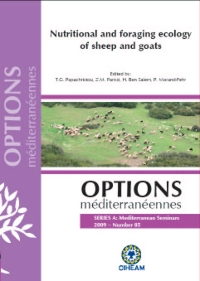| Article précédent | p. 379-385 | Article suivant |
Comparison of the performance of Shami (Damascus) and Saanen goats raised under similar environmental conditions in Lebanon
In Lebanon, Shami goats which are raised and bred randomly by farmers have a large variation in their performance. As a result, many farmers are turning toward famous dairy European breeds. The performance (i.e. milk production, twinning and growth rate) of Shami and Saanen goats was studied for 3 years under local environmental conditions. Average milk yield (from 0-300 days of lactation) was slightly higher (P > 0.05) in Shami goats (450 ± 102.7 kg) compared to Saanen (445 ± 110 kg). Average twinning rate was also higher in Shami goats (1.75 kid/goat) compared to Saanen (1.08 kid/goat). Body weight of Shami goats ranged from 67.4 ± 14.1 kg at parturition to 64.8 ± 10.4 kg after 270 days whereas that of Saanen goats ranged from 51.5 ± 9.3 kg to 51.2 ± 6.6 kg. Average daily growth (g/day) of kids after 270 days was higher (P < 0.05) for Shami kids (males 132.8 ± 31.2; females 108.6 ± 26.5) as compared to Saanen kids (males 117.5 ± 27.2; females 98.6 ± 25.2). Overall, Shami goats have a milk production potential similar to that of Saanen. Shami goats have a higher twinning rate and kid growth rate than Saanen goats, so they can be considered as a dual purpose breed. Apparently, Shami goats seem to adapt well to the environmental conditions (climate, diseases and nutrition) of Lebanese and Mediterranean climate. Thus there is a potential to exploit the genetic productive traits of this breed to enhance milk and meat production in Mediterranean countries.
Au Liban, les chèvres Shami sont élevées et croisées d'une façon aléatoire par des petits groupes d'éleveurs avec une grande variabilité. En conséquence, plusieurs éleveurs se sont orientés vers les élevages laitiers européens. Les performances des chèvres Shami et Saanen sont étudiées durant trois années consécutives. Le rendement moyen de lait (lactation de 0-300 jours) est légèrement supérieur (P > 0,05) pour Shami (450 ± 102,7 kg) par comparaison à Saanen (445 ± 110 kg). Le taux moyen des naissance doubles chez la chèvre Shami (1,75 petits/chèvre) est aussi plus élevé que chez la chèvre Saanen (1,08 petits/chèvre). Le poids vif moyen de la chèvre Shami varie entre 67,4 ± 14,1 kg lors de la parturition et 64,8 ± 10,4 kg après 270 jours, tandis que pour la race Saanen, ce paramètre est de, respectivement, 51,5 ± 9,3 kg et 51,2 ± 6,6 kg. La croissance journalière (g/jour) des petits après 270 jours est plus importante (P < 0,05) pour Shami (mâles 132,8 ± 31,2 ; femelles 108,6 ± 26,5) que pour Saanen (mâles 117,5 ± 27,2 ; femelles 98,6 ± 25,2). Globalement, les chèvres Shami et Saanen ont un potentiel de production laitière similaire. Mais comme les chèvres Shami présentent une meilleure aptitude aux naissances doubles et une meilleure croissance des agneaux, cette race peut donc être considérée comme une race à double fin. Apparemment, les chèvres Shami sont mieux adaptées aux conditions environnementales du Liban. Il y a un potentiel pour exploiter les caractères génétiques de productivité de cette race afin d'améliorer la production de lait et de viande dans les pays méditerranéens.
- [ Afficher ]
- [ Télécharger ]
- [ Exporter la citation ]
Vous pouvez télécharger la citation au format :
- [ Imprimer ]
-
Mots-clés
APTITUDE LAITIERE, CHEVRE, EXPLOITATION LAITIERE, LIBAN, PERFORMANCE ANIMALE, RACE (ANIMAL)Citer cet article
Khazaal K. Comparison of the performance of Shami (Damascus) and Saanen goats raised under similar environmental conditions in Lebanon. In : Papachristou T.G. (ed.), Parissi Z.M. (ed.), Ben Salem H. (ed.), Morand-Fehr P. (ed.). Nutritional and foraging ecology of sheep and goats. Zaragoza : CIHEAM / FAO / NAGREF, 2009. p. 379-385. (Options Méditerranéennes : Série A. Séminaires Méditerranéens; n. 85). 12. Seminar on: Nutritional and Foraging Ecology of Sheep and Goats, 2007/10/11-13, Thessaloniki (Greece). http://om.ciheam.org/om/pdf/a85/00801031.pdf



